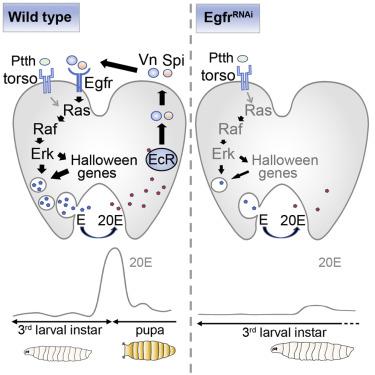当前位置:
X-MOL 学术
›
Curr. Biol.
›
论文详情
Our official English website, www.x-mol.net, welcomes your
feedback! (Note: you will need to create a separate account there.)
Egfr Signaling Is a Major Regulator of Ecdysone Biosynthesis in the Drosophila Prothoracic Gland.
Current Biology ( IF 8.1 ) Pub Date : 2020-03-26 , DOI: 10.1016/j.cub.2020.01.092 Josefa Cruz 1 , David Martín 1 , Xavier Franch-Marro 1
Current Biology ( IF 8.1 ) Pub Date : 2020-03-26 , DOI: 10.1016/j.cub.2020.01.092 Josefa Cruz 1 , David Martín 1 , Xavier Franch-Marro 1
Affiliation

|
Understanding the mechanisms that determine final body size of animals is a central question in biology. In animals with determinate growth, such as mammals or insects, the size at which the immature organism transforms into the adult defines the final body size, as adult individuals do not grow [1]. In Drosophila, the growth period ends when the immature larva undergoes the metamorphic transition to develop the mature adult [2]. This metamorphic transition is triggered by a sharp increase of the steroid ecdysone, synthetized in the prothoracic gland (PG), that occurs at the end of the third instar larvae (L3) [3-6]. It is widely accepted that ecdysone biosynthesis in Drosophila is mainly induced by the activation of tyrosine kinase (RTK) Torso by the prothoracicotropic hormone (Ptth) produced into two pairs of neurosecretory cells that project their axons onto the PG [7, 8]. However, the fact that neither Ptth nor torso-null mutant animals arrest larval development but only present a delay in the larva-pupa transition [9-11] mandates for a reconsideration of the conventional model. Here, we show that Egfr signaling, rather than Ptth/torso, is the major contributor of ecdysone biosynthesis in Drosophila. We found that Egfr signaling is activated in the PG in an autocrine mode by the EGF ligands spitz and vein, which in turn are regulated by the levels of ecdysone. This regulatory positive feedback loop ensures the production of ecdysone to trigger metamorphosis by a progressive Egfr-dependent activation of MAPK/ERK pathway, thus determining the animal final body size.
中文翻译:

Egfr信号传导是果蝇前胸腺中蜕皮激素生物合成的主要调节剂。
了解决定动物最终体型的机制是生物学中的中心问题。在具有决定性生长的动物(例如哺乳动物或昆虫)中,未成年生物转化为成年动物的大小决定了最终的体型,因为成年个体无法生长[1]。在果蝇中,未成熟的幼虫经历了变质转变以发育为成熟的成虫时,其生长期结束[2]。这种变态的转变是由在前三龄幼虫(L3)末端出现的前胸腺(PG)中合成的甾体蜕皮激素的急剧增加触发的。人们普遍认为果蝇中的蜕皮激素的生物合成主要是由促甲状腺激素(Ptth)激活酪氨酸激酶(RTK)躯干引起的,促甲状腺激素生成为两对神经分泌细胞,将它们的轴突投射到PG上[7,8]。然而,Ptth和无躯干的突变动物都不能阻止幼虫的发育,而仅在幼虫-pu过渡中出现延迟[9-11],这一事实要求重新考虑传统模型。在这里,我们表明Egfr信号而不是Ptth /躯干,是果蝇中蜕皮激素生物合成的主要贡献者。我们发现,Egfr信号在PG中以EGF配体斯皮茨和静脉的自分泌模式被激活,而EGF配体的斯皮茨和静脉又受蜕皮激素的水平调节。
更新日期:2020-04-20
中文翻译:

Egfr信号传导是果蝇前胸腺中蜕皮激素生物合成的主要调节剂。
了解决定动物最终体型的机制是生物学中的中心问题。在具有决定性生长的动物(例如哺乳动物或昆虫)中,未成年生物转化为成年动物的大小决定了最终的体型,因为成年个体无法生长[1]。在果蝇中,未成熟的幼虫经历了变质转变以发育为成熟的成虫时,其生长期结束[2]。这种变态的转变是由在前三龄幼虫(L3)末端出现的前胸腺(PG)中合成的甾体蜕皮激素的急剧增加触发的。人们普遍认为果蝇中的蜕皮激素的生物合成主要是由促甲状腺激素(Ptth)激活酪氨酸激酶(RTK)躯干引起的,促甲状腺激素生成为两对神经分泌细胞,将它们的轴突投射到PG上[7,8]。然而,Ptth和无躯干的突变动物都不能阻止幼虫的发育,而仅在幼虫-pu过渡中出现延迟[9-11],这一事实要求重新考虑传统模型。在这里,我们表明Egfr信号而不是Ptth /躯干,是果蝇中蜕皮激素生物合成的主要贡献者。我们发现,Egfr信号在PG中以EGF配体斯皮茨和静脉的自分泌模式被激活,而EGF配体的斯皮茨和静脉又受蜕皮激素的水平调节。











































 京公网安备 11010802027423号
京公网安备 11010802027423号